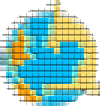 " />
" />

The last years shown a growth of telepathology applications, where Telepathology is a subspecialty of telemedicine aimed at supporting the pathologist's practice by means of telematic tools.
A number of different technical approaches has been developed, to solve different needs related to the practice of pathology at a distance, which is usually considered to include remote consultation, intraoperative telediagnosis, quality control, distant education, and remote image analysis. Some of these tasks need real-time communications, some do not, leading to different solutions. In particular, two large categories of tools may be distinguished:
imprecisely referring respectively to video-based and still-image-based systems.
Dynamic telepathology is often based on videoconferencing-like approaches, while static telepathology, being based on still images, may rely on store-and-forward systems just like email. Due to this, dynamic systems usually require higher investments, either for equipment as well as for running costs.
The recent status of the Internet, and also the forthcoming developments, let suppose that more bandwidth will be available in the future, leading to new capabilities to be exploited also for telepathology.
The present project intends to explore one path towards new Internet telepathology services, based on the complete digitization on the whole histo-cytologic specimen, acting as a Virtual Digital Slide, to be used for diagnostics, education and quality control.
Collections of digital images entirely representing histological/cytological slides, could be the basis for storing and distributing digital copies of glass slides. Several Authors experimented solutions of this kind in the recent times, starting from the pioneering work of Taylor (Acta Cytologica 1999; 43: 1045-1051). However, this is not as easy as digitising radiographs, because the storage space needed is very high.
Let's calculate the storage needed for a specimen of one square cm, which is a typical value for non-biopsy, non cytologic material (biopsies are much smaller, while cytologic samples are much greater). With a conventional 40x objective, the microscope optically resolves about 0.4 micron; as two pixels for each resolved point are needed for digitally representing it, 5 pixels per micron can be considered a safe measure for capturing all image information. This virtually results in a 50000x50000 pixel wide image, for a total of 2.5 billions pixels, which can be captured into a matrix of about 5300 images, using an analog camera with 800x600 resolution.
As resulting from our experimentations, using a common robotized microscope and a PC each image may be acquired in 2-10 seconds on average, including stage movements, autofocus and storage. As a single slide acquisition occurs una tantum and the procedure is fully automated, the 3-15 hours needed for a slide do not represent a problem. Compressed at an appropriate quality level, each image may need about 30 KB to be stored; this results in about 160 MB. Unfortunately, pathologists usually slightly change focus from the main focus plane, to discover further details: this means that one single focus plane is not sufficient, and so the same process should be repeated on three-five planes, with proportional increase of storage size. Lower magnification images might be obtained from the 40x images.
The process of acquisition might be constrained by two main issues, namely:
Apart from the storage needed, appropriate formats should be chosen for storing and distributing such slides. In fact, until now many Authors simply used files named after the coordinates of the represented image, in order to have an easy retrieval of areas. However, every Author used a different system, as there aren't standards in this field (except perhaps for JPEG2000). The possibility of using the DICOM format has been highlighted, although it needs some customization to such particular need.
Finally, also exchange protocols are still not available for delivering cases, as every researcher is developing his/her own solution.
© V.Della Mea, 2002